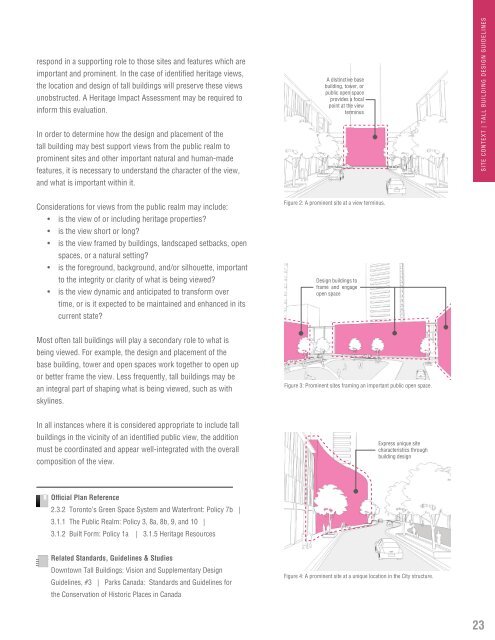tall-buildings
tall-buildings
tall-buildings
Create successful ePaper yourself
Turn your PDF publications into a flip-book with our unique Google optimized e-Paper software.
espond in a supporting role to those sites and features which are<br />
important and prominent. In the case of identified heritage views,<br />
the location and design of <strong>tall</strong> <strong>buildings</strong> will preserve these views<br />
unobstructed. A Heritage Impact Assessment may be required to<br />
inform this evaluation.<br />
In order to determine how the design and placement of the<br />
<strong>tall</strong> building may best support views from the public realm to<br />
prominent sites and other important natural and human-made<br />
features, it is necessary to understand the character of the view,<br />
and what is important within it.<br />
A distinctive base<br />
building, tower, or<br />
public open space<br />
provides a focal<br />
point at the view<br />
terminus<br />
SITE CONTEXT | TALL BUILDING DESIGN GUIDELINES<br />
Considerations for views from the public realm may include:<br />
• is the view of or including heritage properties?<br />
• is the view short or long?<br />
• is the view framed by <strong>buildings</strong>, landscaped setbacks, open<br />
spaces, or a natural setting?<br />
• is the foreground, background, and/or silhouette, important<br />
to the integrity or clarity of what is being viewed?<br />
• is the view dynamic and anticipated to transform over<br />
time, or is it expected to be maintained and enhanced in its<br />
current state?<br />
Figure 2: A prominent site at a view terminus.<br />
Design <strong>buildings</strong> to<br />
frame and engage<br />
open space<br />
Most often <strong>tall</strong> <strong>buildings</strong> will play a secondary role to what is<br />
being viewed. For example, the design and placement of the<br />
base building, tower and open spaces work together to open up<br />
or better frame the view. Less frequently, <strong>tall</strong> <strong>buildings</strong> may be<br />
an integral part of shaping what is being viewed, such as with<br />
skylines.<br />
Figure 3: Prominent sites framing an important public open space.<br />
In all instances where it is considered appropriate to include <strong>tall</strong><br />
<strong>buildings</strong> in the vicinity of an identified public view, the addition<br />
must be coordinated and appear well-integrated with the overall<br />
composition of the view.<br />
Express unique site<br />
characteristics through<br />
building design<br />
Official Plan Reference<br />
2.3.2 Toronto’s Green Space System and Waterfront: Policy 7b |<br />
3.1.1 The Public Realm: Policy 3, 8a, 8b, 9, and 10 |<br />
3.1.2 Built Form: Policy 1a | 3.1.5 Heritage Resources<br />
Related Standards, Guidelines & Studies<br />
Downtown Tall Buildings: Vision and Supplementary Design<br />
Guidelines, #3 | Parks Canada: Standards and Guidelines for<br />
the Conservation of Historic Places in Canada<br />
Figure 4: A prominent site at a unique location in the City structure.<br />
23



